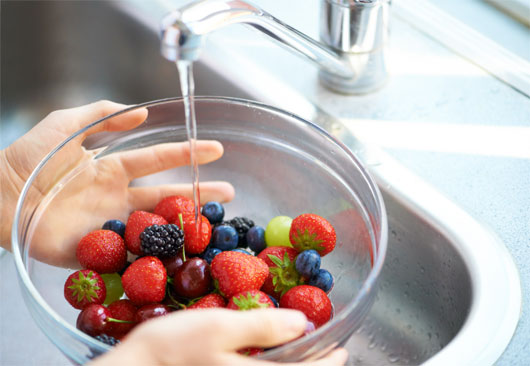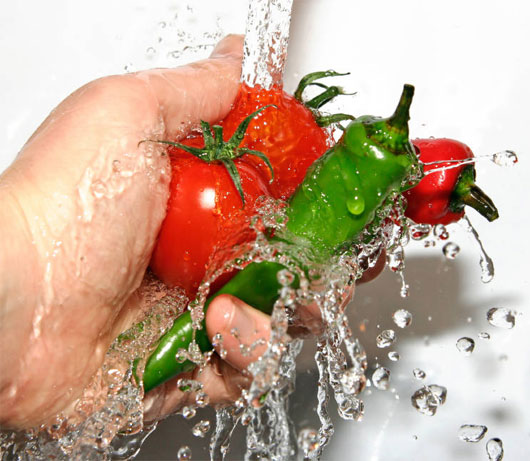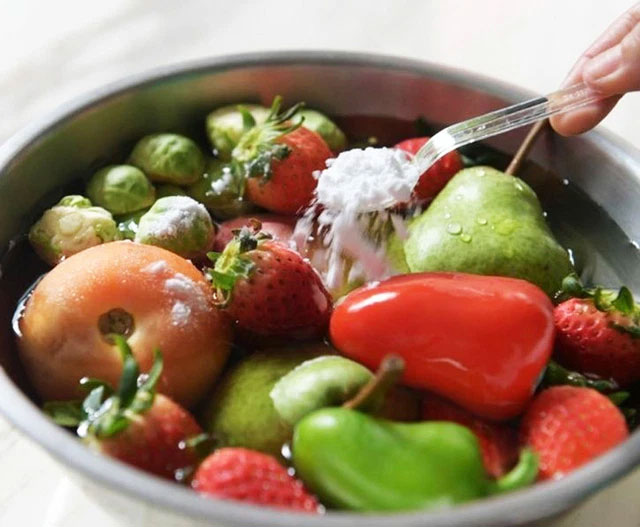Depending on the type of leafy vegetable, root, fruit, or flower, you should have a specific washing method. Vegetables are cleanest when washed under running clean water.
Experts recommend that if vegetables are not washed properly, they remain dirty. Don’t assume that fresh products are safe and free from pathogens. In fact, the opposite is true; fresh fruits and vegetables can still carry pathogens regardless of their appearance.
Common Mistakes When Washing Vegetables
Many people believe that rinsing vegetables 2-3 times is sufficient, thinking that cooking will kill all bacteria and parasites. However, the reality is that to truly clean vegetables, the washing process must be much more thorough. According to Dr. Phan Thanh Tâm from the Food Technology Department at the Post-Harvest Institute of Food Biotechnology, Hanoi University of Science and Technology, rinsing just 2-3 times is unlikely to remove maximum dirt, debris, parasites, microorganisms, or chemical residues such as pesticides that are not visible to the naked eye.

Image: onlymyhealth.com
Researchers at Pham Ngoc Thach University of Medicine in Ho Chi Minh City randomly collected 104 samples of 8 types of commonly consumed raw vegetables, such as lettuce, watercress, morning glory, bok choy, bitter herbs, mustard greens, pennywort, and various herbs (such as mint, perilla, and basil) from local markets for testing. The results revealed that certain vegetables were contaminated with parasites at a rate of 100%, including watercress, bok choy, bitter herbs, mustard greens, and pennywort. The remaining vegetables, such as lettuce, morning glory, and herbs, also showed a 92.3% infection rate.
After washing these vegetables 3 times with clean water using the conventional method, they were tested again. The results indicated that even after 3 washes with clean water and a specialized washing solution, the rate of parasitic contamination still ranged from 51.9% to 82.6%.
Many people believe that blanching vegetables before cooking is a safe method, but this is also a misconception. Master Nguyen My Linh from the Vegetable and Spice Institute of Vietnam states that the habit of washing and blanching vegetables before cooking to ensure hygiene and maintain color is unnecessary and even wasteful. This blanching process can reduce vitamins and eliminate compounds that help prevent cancer found in vegetables.
Fruit and Vegetable Washes Are Not Absolutely Safe
In addition to soaking fruits and vegetables in salt water, many homemakers are familiar with fruit and vegetable washes available on the market. The main ingredients of these solutions typically include deionized water, citric acid, sodium, and fragrances. However, these washes cannot eliminate all bacteria from vegetables. According to Mrs. Nguyen Thi Hoa, head of the Plant Protection Department in Hanoi, these fruit washes are not miracle solutions that can completely remove all harmful chemicals from fruits and vegetables.
Fruit and vegetable washes can quickly remove surface dirt and some harmful chemicals, but pesticides often penetrate deeply. When harmful chemicals seep into the produce, cleaning solutions cannot fully exert their effects. For fruits and vegetables that have been sprayed for an extended period, the chemicals can penetrate deeply, rendering the wash nearly ineffective. Furthermore, there are many active ingredients in pesticides and numerous brands producing them, each with unique properties; some active ingredients may wash away certain fruits and vegetables but not others.

Image: blog.energyearth.com
Similarly, Associate Professor Dr. Ngo Quoc Quyen from the Institute of Chemistry, Vietnam Academy of Science and Technology, confirms that there is no cleaning product that can guarantee vegetables are cleaned absolutely. If vegetable washes use substances like deionized water, they only have disinfecting properties and lack the ability to clean. Using chemical substances for cleaning may also lead to adverse effects.
Vegetable Washing Machines Can Be Counterproductive
Currently, there are many types of vegetable washing machines using ozone technology on the market. According to Mr. Duong Minh Tri, Deputy Director of the Ho Chi Minh City Institute of Physics, scientifically, ozone is a highly toxic gas that can cause cancer. Therefore, it should not be used in households or kitchens. To effectively wash away pesticides and harmful substances from fruits and vegetables, these ozone machines must maintain a sufficient concentration of ozone in the water. However, if the concentration is adequate for disinfection or possibly insufficient, the gas will escape into the kitchen, directly affecting the health of the homemaker.
Moreover, scientifically, ozone should not be used in water that already contains chlorine, as it can create a new, stable toxic compound. Currently, tap water contains a significant amount of chlorine.
Washing Principles for Different Types of Vegetables
According to experts, vegetables can be categorized into four types: leafy, fruit, root, and flower. Each type has different risks of contamination and pollution, so they should be washed accordingly.
Leafy vegetables are considered the most contaminated and have a high risk of carrying pathogens due to the presence of E. coli and Salmonella from direct fertilization on the leaves. Therefore, upon purchasing, it is essential to clean the vegetables, soak them in water, and wash each leaf and stem under running water. Delicate vegetable stems, such as morning glory, should be washed multiple times, then rinsed in small bundles under running water. The best current method to eliminate pathogens is to soak them in water. A basin of about 10 liters should contain just a teaspoon of salt, soaking for 5 minutes.

Image: thevegworld.com
Fruiting vegetables are generally less contaminated than leafy ones since they mostly grow on trellises, thus experiencing less direct fertilization. However, fruiting vegetables are susceptible to pesticide contamination due to early harvests not adhering to pesticide withdrawal periods or during storage. When purchased, do not consume them immediately as is common in Vietnamese habits. Instead, wash each fruit thoroughly, wrap them in plastic, and refrigerate for consumption after 2 days. This method preserves freshness while allowing time for pesticide degradation. Fruits and vegetables intended for immediate consumption should be washed under running water and soaked in salt water. Avoid soaking in salt water and then refrigerating for later use, as fruits can spoil easily.
Root vegetables are generally safer, so there is no need to soak them in salt water or potassium permanganate. When preparing root vegetables, wash the skin thoroughly, then peel and wash again. This method minimizes dirt from the skin contaminating the peeled flesh.
Flower vegetables are considered the most hygienic. Flowers typically grow high and are less likely to be contaminated by pesticides or fertilizers sprayed directly, making them difficult to soil. When sprayed, growers must cover the flowers with leaves, so washing them under running water ensures safety.
Herbs only require a quick rinse. Herbs such as green onions, dill, or smooth-skinned fruits like tomatoes, eggplants, and fresh peppers should also be washed thoroughly like other vegetables, as many places growing herbs may be dirtier than vegetables, with fresh manure being used, thus posing a high risk of parasitic contamination.
The Quickest Way to Eliminate Bacteria
Wash everything, including products labeled as “ready to eat” or “wash before eating.” Remember that even if you peel or scrape off the outer layer, germs, dirt, and pesticides on the surface can still spread to what you ultimately consume.
It is advisable to wash vegetables under clean running water: Use tap water, preferably cold. For soft fruits or vegetables, gently scrub for half a minute to a minute, avoiding vigorous scrubbing that may bruise them. For tough-to-clean products, use appropriate brushes.
Do not use soap, detergents, or bleach: These substances can penetrate the produce. There is no guarantee that these substances will make fruits and vegetables cleaner than other washing methods.
Wash thoroughly: Ensure that after washing, the fruits and vegetables are clean, with no wrinkles or cracks left on the surface, removing any spoiled parts and outer leaves.
Dry fruits and vegetables: Use clean paper towels to dry fruits to eliminate any remaining bacteria after washing.
Simple Methods to Reduce Pesticide Residue
According to nutrition expert Dr. Cao Thi Hau, to achieve high yields or to eliminate pests, especially for certain fruits and vegetables that are prone to pest damage, some farmers have excessively used chemical fertilizers or sprayed pesticides close to harvest time, failing to adhere to the regulations regarding the pre-harvest pesticide application period. Additionally, some fruits and vegetables are grown in contaminated soil, irrigated with fresh manure or polluted water, posing a serious threat to consumer health. Therefore, to reduce pesticide levels in fruits and vegetables, you should:
1. Soak vegetables in clean water for about 5-10 minutes before rinsing, or use rice water for soaking to neutralize the toxicity of pesticides.
2. Wash vegetables with a 5% saltwater solution.
3. For cucumbers, eggplants, or other fruits and vegetables with high pesticide levels, it’s best to wash them thoroughly and peel the skin before consumption.
4. Heating at high temperatures can also decompose pesticides. Some heat-tolerant vegetables like broccoli, beans, and celery should be washed and then blanched in hot water for 2 minutes, which can reduce pesticide levels by 30%. Cooking at high temperatures afterward can eliminate up to 90% of pesticide residues.
5. Sunlight can break down and decompose pesticide residues on vegetables. Leaving vegetables under sunlight for 5 minutes can reduce residues like organic mercury and organic chlorine by approximately 60%.
Cautions When Washing Vegetables with Saltwater

A high-salt diet is not good for health. (Illustrative image).
According to Associate Professor Dr. Nguyen Duy Thinh, former lecturer at the Institute of Biotechnology and Food Technology, Hanoi University of Science and Technology, as shared on Health and Life, soaking fruits and vegetables in saltwater only moderately inhibits or kills bacteria; it does not automatically eliminate harmful chemicals from food.
Moreover, soaking fruits and vegetables in saltwater for too long can lead to nutrient loss, cause the vegetables to become bruised, and result in a loss of flavor when cooked. “The vitamin and mineral content in vegetables soaked this way will significantly diminish. Additionally, soaking vegetables in water for too long can be harmful to health, as contaminants may seep back into the produce,” stated Thinh.
Not to mention the possibility of removing hidden pesticide residues from fresh produce, Associate Professor Dr. Tran Hong Con (lecturer at the Department of Chemistry, University of Science, Vietnam National University) has made a surprising assertion: “To date, there is no scientific research confirming that saltwater can kill parasitic eggs, bacteria… let alone remove chemicals from fruits and vegetables as many people believe.”
Numerous studies have shown that soaking fruits and vegetables in high-concentration saltwater for extended periods increases osmotic pressure, leading to salt contamination.
Meanwhile, according to the World Health Organization (WHO), the average Vietnamese adult consumes up to 9.4g of salt per day, nearly double the recommended intake of 5g per day. Thus, Vietnam is one of the saltiest countries in the world. Actively incorporating more salt into daily meals, soaking additional food in saltwater further increases your family’s salt consumption. This creates a significant burden on the kidneys, leading to hypertension and cardiovascular diseases.


















































